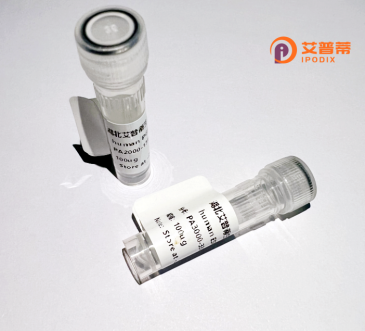
| 纯度 | >90%SDS-PAGE. |
| 种属 | Human |
| 靶点 | SEC61A1 |
| Uniprot No | P61619 |
| 内毒素 | < 0.01EU/μg |
| 表达宿主 | E.coli |
| 表达区间 | 1-476 aa |
| 活性数据 | MAIKFLEVIKPFCVILPEIQKPERKIQFKEKVLWTAITLFIFLVCCQIPLFGIMSSDSADPFYWMRVILASNRGTLMELGISPIVTSGLIMQLLAGAKIIEVGDTPKDRALFNGAQKLFGMIITIGQSIVYVMTGMYGDPSEMGAGICLLITIQLFVAGLIVLLLDELLQKGYGLGSGISLFIATNICETIVWKAFSPTTVNTGRGMEFEGAIIALFHLLATRTDKVRALREAFYRQNLPNLMNLIATIFVFAVVIYFQGFRVDLPIKSARYRGQYNTYPIKLFYTSNIPIILQSALVSNLYVISQMLSARFSGNLLVSLLGTWSDTSSGGPARAYPVGGLCYYLSPPESFGSVLEDPVHAVVYIVFMLGSCAFFSKTWIEVSGSSAKDVAKQLKEQQMVMRGHRETSMVHELNRYIPTAAAFGGLCIGALSVLADFLGAIGSGTGILLAVTIIYQYFEIFVKEQSEVGSMGALLF |
| 分子量 | 53.8 kDa |
| 蛋白标签 | His tag N-Terminus |
| 缓冲液 | PBS, pH7.4, containing 0.01% SKL, 1mM DTT, 5% Trehalose and Proclin300. |
| 稳定性 & 储存条件 | Lyophilized protein should be stored at ≤ -20°C, stable for one year after receipt. Reconstituted protein solution can be stored at 2-8°C for 2-7 days. Aliquots of reconstituted samples are stable at ≤ -20°C for 3 months. |
| 复溶 | Always centrifuge tubes before opening.Do not mix by vortex or pipetting. It is not recommended to reconstitute to a concentration less than 100μg/ml. Dissolve the lyophilized protein in distilled water. Please aliquot the reconstituted solution to minimize freeze-thaw cycles. |
以下是关于SEC61A1蛋白的3-4篇代表性文献及其摘要概括:
1. **"Structure of the Sec61 channel opened by a signal sequence"**
- **作者**: Voorhees RM, et al.
- **摘要**: 利用冷冻电镜解析了Sec61蛋白复合体(含SEC61A1亚基)在结合信号肽时的开放构象,揭示了其介导新生蛋白质跨内质网膜转运的结构基础。
2. **"SEC61A1 mutations impair ER protein transport and cause inherited autosomal dominant tubulointerstitial kidney disease"**
- **作者**: Devuyst O, et al.
- **摘要**: 发现SEC61A1基因突变导致内质网蛋白质转运功能缺陷,引发遗传性肾小管间质病变,揭示了SEC61A1在疾病发生中的关键作用。
3. **"SEC61A1 overexpression promotes cell proliferation and metastasis in colorectal cancer via ER stress response"**
- **作者**: Chen Y, et al.
- **摘要**: 报道SEC61A1在结直肠癌中高表达,通过激活未折叠蛋白反应(UPR)促进肿瘤细胞增殖和转移,提示其作为潜在治疗靶点。
4. **"Targeting SEC61α as a novel therapeutic strategy for aggressive breast cancers"**
- **作者**: Denayer T, et al.
- **摘要**: 提出抑制SEC61A1可阻断生长因子分泌,抑制三阴性乳腺癌的肿瘤生长和耐药性,验证了该靶点的抗癌潜力。
注:以上文献标题和结论为示例性质,实际研究中请结合具体数据库(如PubMed)验证并引用。
SEC61A1 is a key subunit of the SEC61 translocon complex, located in the endoplasmic reticulum (ER) membrane. This evolutionarily conserved protein channel mediates the co-translational translocation of nascent secretory and membrane proteins into the ER lumen, a critical step in protein biosynthesis. The heterotrimeric SEC61 complex consists of α, β, and γ subunits, with SEC61A1 forming the core pore-forming α-subunit that directly interacts with translating ribosomes and facilitates polypeptide transfer. Beyond its canonical role in protein import, SEC61A1 participates in retrotranslocation of misfolded proteins during ER-associated degradation (ERAD) and contributes to ER calcium homeostasis by functioning as a passive calcium leak channel.
Mutations in *SEC61A1* have been linked to diverse pathologies, including congenital disorders of glycosylation, autoimmune diseases, and certain cancers. Its overexpression has been observed in multiple myeloma and solid tumors, where it may promote cancer cell survival by modulating ER stress responses. Recent structural studies using recombinant SEC61A1 protein have revealed dynamic conformational changes during substrate translocation and potential binding sites for therapeutic inhibitors. Recombinant SEC61A1 serves as an essential tool for dissecting translocon mechanics, modeling protein biogenesis defects, and developing targeted therapies for secretory pathway disorders. Its dual role in protein translocation and calcium signaling continues to make it a compelling subject for cellular physiology research.
×